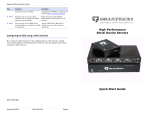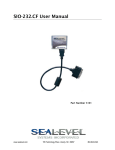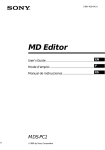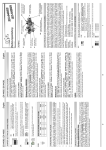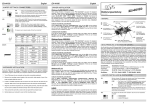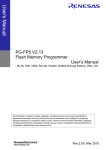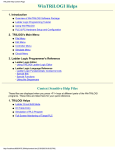Download Quatech SSCF-200 User`s manual
Transcript
User’s Manual SSCFSSCF-200/300 One Port RS-422/485 Serial CompactFlash Card QUATECH, INC. 5675 Hudson Industrial Parkway Hudson, Ohio 44236 TEL: (330) 655-9000 FAX: (330) 655-9010 http://www.quatech.com. CompactFlash Card User’s Manual P/N: 940-0190-110 Version 1.10, 02.05.04 Copyright (c) 2003-2004, Quatech, Inc. This manual is copyrighted. All rights are reserved. The information contained in this document cannot be reproduced in any form without the written consent of Quatech, Inc. Likewise, any software programs that might accompany this document can be used only in accordance with any license agreement(s) between the purchaser and Quatech, Inc. Quatech Inc. reserves the right to change this documentation or the product to which it refers at any time and without notice. Trademarks CompactFlash is a trademark of Sandisk Corporation. IBM®, PC®, and PC-AT® are trademarks of the International Business Machines Corporation. Windows®, Windows 95®, Windows 98®, Windows NT®, Windows 2000®, Windows Me®, Windows XP®, Windows CE® and MS-DOS® are trademarks of the Microsoft Corporation. All other trademarks or registered trademarks are property of their respective owners. Disclaimer The authors have taken due care in the preparation of this document and every attempt has been made to ensure its accuracy and completeness. In no event will Quatech, Inc. be liable for damages of any kind, incidental or consequential, in regard to or arising out of the performance or form of the materials presented herein or in any software program(s) that may accompany this document. Changes or modifications to this device not explicitly approved by Quatech will void the user's authority to operate this device. Feedback Quatech, Inc. encourages and appreciates feedback concerning this document. Please send any written comments to the Technical Support department at the address listed on the cover page of this manual. -2- Quatech CompactFlash Card User’s Manual SSCF-200/300 Table of contents 1. Overview --------------------------------------------------------------------------------------------------- 4 2. About The SSCF-200/300------------------------------------------------------------------------------ 4 3. Installing The SSCF-200/300 ------------------------------------------------------------------------- 5 3.1 Windows CE, PocketPC------------------------------------------------------------------------- 5 3.2 Windows 95, 98, Me, 2000, XP ---------------------------------------------------------------- 5 3.3 DOS & Windows 3.x ----------------------------------------------------------------------------- 5 4. SSCF-200/300 Register Interface -------------------------------------------------------------------- 5 5. Hardware Specification -------------------------------------------------------------------------------- 6 5.1 Pinout ----------------------------------------------------------------------------------------------- 6 5.2 Electrical-------------------------------------------------------------------------------------------- 7 5.3 Power Consumption ----------------------------------------------------------------------------- 7 5.4 Mechnaical ----------------------------------------------------------------------------------------- 7 5.5 Environmental ------------------------------------------------------------------------------------ 7 5.6 Notes on Serial Data Throughput ------------------------------------------------------------ 8 5.7 Baud Rate Settings -------- -------------------------------------------------------------------------8 6. Using The SSCF-200/300 ------------------------------------------------------------------------------ 9 6.1 Termination---------------------------------------------------------------------------------------- 9 6.2 Fail Safe Open Circuit Protection------------------------------------------------------------ 9 6.3 TxD and RTS Drivers --------------------------------------------------------------------------- 9 6.4 RS-422 Operation------------------------------------------------------------------------------- 10 6.5 RS-485 Operation------------------------------------------------------------------------------- 10 7. Warranty-----------------------------------------------------------------------------------------------------11 -3- Quatech CompactFlash Card User’s Manual SSCF-200/300 1. Overview The SSCF-200/300 card is a single port RS-422/485 Serial CompactFlash card with the following features: • • • • • • • • • • • • • Type I CompactFlash form factor for CF+ equipped PDAs, Handheld, Laptop, & Tablet PCs Windows 95/98/Me/2000/XP/CE, PocketPC, DOS compatible using O.S. standard drivers Industry standard 16550 register set. Transmission rates up to 115.2K Baud as standard. Switchable x1 or x8 baud rate providing up to 921Kbaud. Compatible with 3.3V and 5V systems. Hardware modem control line support. Compatible with standard PCMCIA slots using CompactFlash Adapter (not included) Standard PC IO port decode for COM1 to COMn “Any” IO port and interrupt decode option for best PNP flexibility ESD protected RS-422/485 drivers Software controlled power management Low power consumption Supplied with 300mm DB9-male terminated cable 2. About the SSCF-200/300 The SSCF-200/300 is a RS-422/485 serial card with a 16550 compatible UART ASIC device. The serial data and control lines are buffered using ESD protected RS-422/485 drivers. Industry standard baud rates up to 115.2K baud are supported, together with 16-byte deep TX and RX FIFOs. A small switch located at the back edge of the card can be used to select a “x1” or “x8” baud rate multiplier. This feature enables up to 921KBaud operation without requiring special device drivers on the host (in x8 mode you simply multiply the setting shown on the host by 8 to get the real serial data rate e.g. 19200 Baud set on host with x8 mode gives 153600Baud true rate in hardware). See section 5 for the switch settings. The SSCF-200/300 conforms to the industry standard CompactFlash+ interface that allows connection of peripherals to the system bus of a laptop, handheld PC or PDA. The CF+ specification extends the earlier memory-only CompactFlash interface to enable the use of I/O devices and to provide the extra power required by I/O cards. The SSCF-200/300 is an I/O type device and therefore requires a CF+ capable slot. -4- Quatech CompactFlash Card User’s Manual SSCF-200/300 3. Installing the SSCF-200/300 3.1 Windows CE, PocketPC There is no need to install any software for Windows CE or PocketPC. Simply insert the SSCF200/300 card and it will appear in a list when you set up a “Connection.”For more information about setting up a “Connection” see the manual for your handheld device. 3.2 Windows 95, 98, 98SE, Me, 2000, XP The “generic” serial drivers in these Operating Systems support the SSCF-200/300. Before inserting the card, however, execute the SERIALSETUP.EXE program provided on the Quatech Data Communication CD in the Serial Port Adapters\Drivers\Windows 95, 98, Me, 2000, XP for CompactFlash directory. 3.3 DOS & Windows 3.1x Operation in DOS or Windows 3.1 requires 3rd party Card and Socket Services drivers to be properly installed and configured. Follow your software vendor’s instructions on how to do this. The SSCF-200/300 requires no extra drivers to operate in DOS. Insertion of the card should create a familiar “happy beep” as the host software configures the card as a standard DOS COM port. Resource allocation and troubleshooting is all related to the 3rd party software and any issues that may arise during configuration should be addressed to the vendors of this software. The SSCF200/300 has been tested with: SystemSoft Cardware and Award Cardwizard 4. SSCF-200/300 Register Interface For reference, the SSCF-200/300 behaves as a 5V card to the host system because Vs1 and Vs2 pins are not connected. This is to make the host default to 5V when possible, giving the highest RS422/485 output signals and therefore the best noise margins. The Card Information Structure (CIS) does not define any 3.3V tuples because some platforms will also take this as a sign to run at 3.3V even when 5V is available. On a PDA or HPC, the host will power the card at 5V if it is available, or at 3.3V if that is the only option (despite there being no 3.3V tuple entries). -5- Quatech CompactFlash Card User’s Manual SSCF-200/300 5. Hardware Specification 5.1 PINOUT The SSCF-200/300 is supplied with a 300mm long Type 46 cable that terminates with a DB9 Male connector with female screwlocks (to match the port at the back of a PC) The pin-out below applies to both the SSCF-200/300 card and the DB9 male connector on the supplied cable (the cable is pinned one-to-one). PIN 1* 2 3 4 5 6 7 8 9 NAME RXDRXD+ TXDTXD+ GND CTSRTSCTS+ RTS+ FUNCTION Receive Data inverting input Receive Data non-inverting input Transmit Data inverting output Transmit Data non-inverting output GROUND Clear To Send inverting input Request To Send inverting output Clear To Send non-inverting input Request To Send non-inverting output For ref: mating connector type: Honda rmc-e9f2s-bsla2n-a2 *Pin 1 is nearest the edge of the card. x8 PIN 9 PIN 1 x1 Baud multiplier switch -6- Quatech CompactFlash Card User’s Manual SSCF-200/300 5.2 ELECTRICAL All figures quoted are typical parameters @ 25°C ESD PROTECTION: All RS-422/485 signal lines on the SSCF-200/300 card are protected against electrostatic discharge (ESD) • >1kv – IEC1000-4-4 UART CLOCK SPEED: x1: UART CLOCK is 1.8432MHz ->115.2KBaud max x8: UART CLOCK is 14.7456MHz->921.6KBaud max RS-422 MODE: CTS/RTS flow control signals available. RS-485 MODE: Auto-tristate of TXD drivers when not transmitting TERMINATORS: None fitted in card, use an external termination resistor as required. FAIL-SAFE FEATURE: The receiver inputs include a fail-safe feature that guarantees a logic high on the receiver when the inputs are open circuit. 5.3 POWER CONSUMPTION All figures quoted are typical parameters @ 25°C COMMUNICATION ACTIVE: 80mA typical @ 5V, 55mA typical @ 3.3V (includes 45mA consumed by terminating resistors) IDLE MODE : 22mA typical @ 5V, 10mA typical @ 3.3V 5.4 MECHANICAL MASS: 10g typical. FORM FACTOR: 36.4mm x 42.8mm x 3.3 mm overall size 5.5 ENVIRONMENTAL HUMIDITY: <80% non-condensing TEMP: 0-50°C ambient -7- Quatech CompactFlash Card User’s Manual SSCF-200/300 5.6 NOTES ON SERIAL DATA THROUGHPUT The maximum serial baud rate of 921KBits/sec does not imply that the maximum sustained throughput rate of the serial port will be as high. The actual throughput rate that can be achieved depends on many factors including the host PC speed, the serial data source’s data block size and whether the block are “back-to-back”, whether the interrupt in use on the host is being shared by other devices leading to increased latency, etc. As a simple rule of thumb, using the standard serial drivers on a fast PC will allow throughput rates of 400-600KBits/sec although these rates can’t be guaranteed and will be application specific. 5.7 BAUD RATE SETTINGS The table below illustrates the common baud rate values available for each of the baud rate multiplier switch positions: HOST SETTING 300 1200 2400 4800 9600 19200 38400 57600 115200 SWITCH = x1 300 1200 2400 4800 9600 19200 38400 57600 115200 SWITCH = x8 2400 9600 19200 38400 76800 153600 307200 460800 921600 -8- Quatech CompactFlash Card User’s Manual SSCF-200/300 6. Using the SSCF-200/300 Card 6.1 TERMINATION RS-422 and RS-485 lines should be terminated at the end of the main branch of the receiver with the cables characteristic impedance. These terminating impedances reduce signal reflections at the cable end. It is not necessary to terminate the transmitter end of the cable. The most common method of termination is to install a terminating resistor, typically with a value of 120Ω, at a single receiver. The SSCF-200/300 does not have internal terminating resistors fitted as standard. If required, a 120Ω resistor should be connected between the RXD+ and RXD- pins of the DB9 connector. For RS422 applications, a terminating resistor will also be required between the CTS+ and CTS- pins. 6.2 FAIL SAFE OPEN CIRCUIT PROTECTION A transmission line enters an indeterminate state if no drivers are transmitting on it or the line has been cut. This indeterminate state can cause the receivers to receive invalid data bits from noise picked up on the cable. To prevent reception of these data bits, the SSCF-200/300 receiver inputs incorporate 1.2kΩ bias resistors (one pulling up on “+” and one pulling down on “-“) that ensure that the differential voltage on the RXD and CTS pairs is greater than the 200mV input logic “1” threshold (even in the presence of an external 120Ω terminating resistor). 6.3 TXD AND RTS DRIVERS The RTS signal driver on the SSCF-200/300 is always enabled, regardless of the mode in which the card is to be used. The SSCF-200/300 incorporates an auto-tristate feature on the TXD signal driver. The driver is enabled only when data is in the process of being transmitted. This mechanism can prevent bus contention in RS-485 systems (caused by multiple transmitters driving the line in opposing states). The RS-485 transmitter arbitration scheme is beyond the scope of this guide, and is typically handled by application software. Note that when multiple characters are transmitted “back-to-back” the output drivers stay active for the entire duration of the transmission i.e. the drivers do not go in and out of tri-state for each character in a multi-character block. The auto-tristate feature is always in operation, regardless of the mode in which the card is to be used. -9- Quatech CompactFlash Card User’s Manual SSCF-200/300 6.4 RS-422 OPERATION Generally, in RS-422 systems, all 8 signal lines from the DB9 connector are used. Thus 4 twisted pair cables are used, one pair for each of the 4 signals TXD, RXD, RTS and CTS. The RS-422 arrangement allows data to be transmitted and received simultaneously since each signal has its own twisted pair. 6.5 RS-485 OPERATION The SSCF-200/300 can be used for both half-duplex (one twisted pair) and full-duplex (two twisted pairs) arrangements, however for half-duplex mode, the link between the TXD and RXD signals must be made externally on the DB9 connector. Also, it should be noted that the transmitted characters will always be received in this mode. The RXD receiver is not disabled during transmission. The handshaking signals RTS and CTS, although driven by the card, are usually not connected to another node. However, if required by the application software, to force the CTS signal input on the SSCF-200/300 true, the RTS signals must be looped back to the CTS inputs. - 10 - Quatech CompactFlash Card User’s Manual SSCF-200/300 7. Warranty Information Quatech, Inc. warrants the SSCF-200/300 to be free of defects for five (5) years from the date of purchase. Quatech, Inc. will repair or replace any board that fails to perform under normal operating conditions and in accordance with the procedures outlined in this document during the warranty period. Any damage that results from improper installation, operation, or general misuse voids all warranty rights. No representation is made regarding the suitability of this product for any particular purpose. Please complete the following information and retain for your records. DATE OF PURCHASE: ____________________________ MODEL NUMBER: SSCF-200/300 PRODUCT DESCRIPTION: One Port RS-422/485 CompactFlash Card SERIAL NUMBER: ____________________________ All products returned to Quatech for either warranty or non-warranty repair MUST be assigned a Returned Material Authorization (RMA) number prior to shipment. This RMA number must be clearly marked on the exterior of the product’s return packaging and in any correspondence to ensure proper routing and prompt attention. To obtain an RMA number, contact Quatech Technical Support Department at 1-800-553-1170 or (330) 655-9000 or submit the RMA request form on the Quatech website. In order to prevent damage to returned merchandise during shipment, please package electronic components in anti-static/shock proof materials. For warranty repair/returns, please have the following information available when contacting the Technical Support department: 1. Model number and serial number of the product under warranty 2. Repair instructions and/or specific description of the problem For non-warranty repairs or upgrades, contact the Technical Support department for current repair charges and please have the following information available: 1. Purchase order number to cover the cost of the service 2. Model number and serial number of the product 3. Repair or upgrade instructions relative to the product - 11 -











